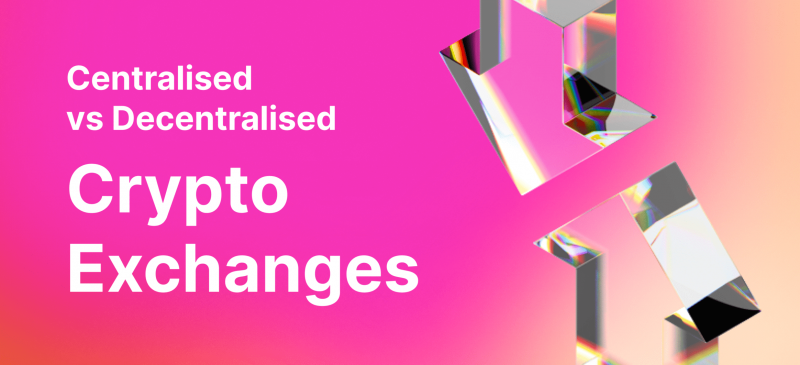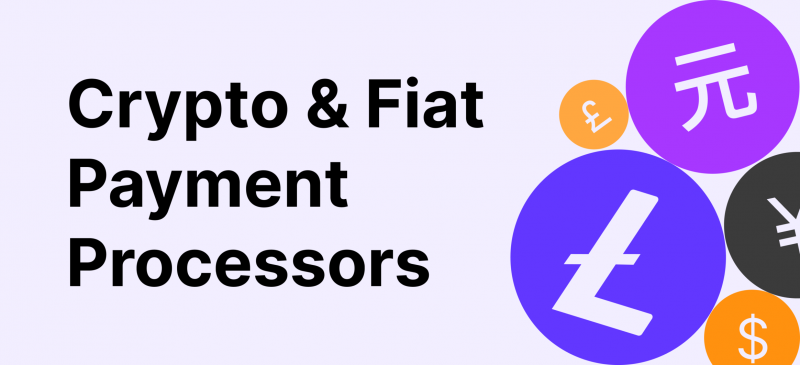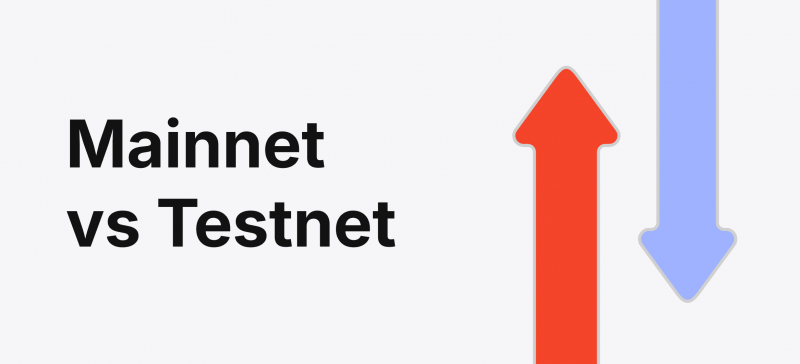Decentralisation has become an infamous buzzword in the crypto landscape. Institutional investors, large-scale organisations, and even individual crypto traders are drawn to this flagship quality of crypto since it provides freedom that is simply unavailable in conventional finance. Thus, decentralisation can be considered a main attraction that popularised crypto assets in the first place back in 2009.
However, decentralised crypto exchanges have inherent limitations that decrease user adoption and pose challenges with complexity. Thus, centralised crypto exchanges are still the more popular option. This article will explore both variations and pinpoint the crucial differences between centralised vs decentralised crypto exchanges that you should consider in your trading decisions.
Key Takeaways
- Crypto exchanges allow investors to engage in various trading activities and acquire desired crypto assets with tight spreads.
- Centralised exchanges prioritise convenience, accessibility, lower transaction costs and price stability.
- Decentralised deals aim to preserve blockchain’s anonymity and freedom aspects, offering a platform that does not have central authorities.
- Choosing between these options depends on your specific preferences and scope of operations.
What is A Crypto Exchange?
First, let’s answer the fundamental question – what is a crypto exchange, and how does it function? Unlike its conventional alternative, a crypto exchange platform allows traders to purchase and sell desired cryptocurrencies without geographical limitations. While this is a baseline requirement, most crypto exchanges boast additional features and functionalities, including advanced analytics tools, live price reports and data feeds, complex trading options and even margin trading possibilities.
Simply put, modern crypto exchanges accommodate a wide array of trading services, creating a full-stop environment for crypto investors and giving them all the necessary tools to succeed. The primary purpose of crypto exchanges is to provide fair market quotes on trading pairs, prevent slippage and ensure that spread margins are within acceptable limits. The above-outlined factors are vital for the crypto market, as they directly facilitate increased trading activities across the globe. Tighter spread margins make it cheaper to exchange crypto, minimised slippage means that investors incur no losses during trading activities, and fair market prices simplify the search for the best available deals.
The increased focus on price stability and decentralisation differentiates the crypto exchanges from the fiat platforms. The crypto market is much more volatile compared to the fiat. Thus, exchange platforms must employ different methods to stabilise their price offerings without sacrificing the underlying blockchain principles. Thus far, achieving this milestone has proven difficult, and two significant variations of exchanges tackle the decentralisation problem differently. Let’s explore.
Defining Centralised Exchanges

Even though decentralisation is one of the cornerstones of blockchain technology, the three most popular crypto exchanges – Binance, Coinbase and Kraken – are centralised (CEX). While this might seem like a paradox, the reason is quite simple. In the current climate, a CEX cryptocurrency exchange is much better equipped to handle the volatility and complexity of the crypto market.
First, it is no secret that the crypto industry struggles with price stability concerns. After all, cryptocurrencies are digital assets that have yet to acquire a benchmark utility that makes them invaluable to the global economy. While Ethereum’s smart contracts and Bitcoin ordinals are making a push to establish substantial inherent value for crypto, they are still a ways off. Thus, the entire market is experiencing frequent volatility swings, creating additional market risks for crypto investors.
The Wide-Spread Appeal of Centralised Exchanges
In this environment, crypto investors need to know that professionals handle their finances instead of automated algorithms. A centralised exchange is supervised and governed by central authorities that manually respond to various price shifts, spread margin changes and other curve balls thrown by the unstable crypto economy. While this method is far from ideal and doesn’t guarantee complete safety for users, it is the most proven approach in the current blockchain landscape.
The second most important feature of centralised exchanges is their ability to provide convenience across the board. The involvement of third-party supervisors means that each service, feature and functionality on the platform can be set up to rival the accessibility of standard fiat exchanges. Thus, centralised exchanges have managed to closely resemble the popular fiat platforms, creating a sense of familiarity that is highly attractive to average crypto users.
What Is A DEX? Understanding Decentralised Exchanges
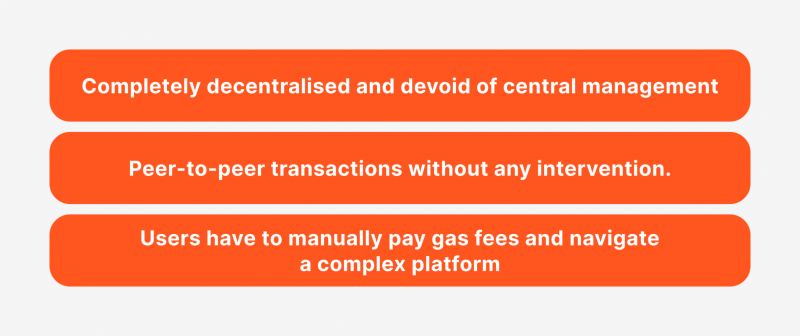
On the flip side, decentralised (DEX) crypto exchanges seek to preserve the pure essence of decentralisation and offer a trading platform that eliminates all middlemen. In theory, this approach should not be complex. The exchange should provide all trading options automatically and let the traders decide everything else.
This approach seems feasible and even more straightforward than the chaotic centralised method. An entirely different picture is painted in practice. Operating an exchange platform requires careful balancing, an on-demand supply of liquidity and numerous tweaks to keep the system from collapsing under its weight. The trading landscape can become hostile as numerous individuals seek loopholes to exploit and manipulate the market for their benefit.
With decentralised exchanges, the smart contract system that manages everything is the only line of defence against market fluctuations and manipulation. SCs control prices, spread margins, order matching choices, leverage ratios, various contract options and many other systems. Naturally, managing each of these variables is a tall order on its own and smart contracts are simply not capable of making critical decisions if the abrupt shifts in the crypto economy demand it. Thus, a standard decentralised exchange will offer fewer trading options and mostly stick to presenting essential trading pairs.
Peer-to-peer exchange platforms can be flawless in theory but currently suffer from optimisation problems, liquidity misallocation and a general lack of user accessibility.
Centralised And Decentralised Exchanges: Direct Comparison
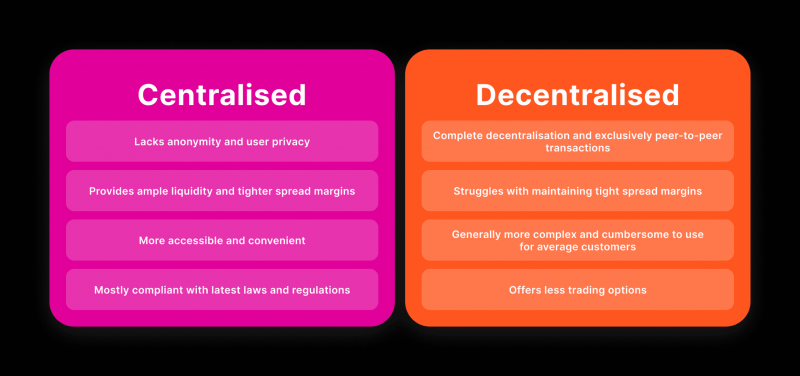
After understanding the fundamentals of both platform variations, let’s delve deeper into centralised vs decentralised crypto exchanges. Naturally, there is no obvious answer here, as both options present robust features to be considered. On the other hand, both alternatives are limited in critical aspects, and it is vital to understand the specific differences to make an informed decision.
The Decentralisation Problem
First and foremost, the fundamental difference between these platform variations is their decentralisation aspect. The centralised platforms have sacrificed this principle for convenience, stability and the high variation of advanced trading features. As a result, centralised exchanges are susceptible to management and employee fraud, cybersecurity concerns, money laundering and overall lack of desired anonymity.
Conversely, DEX platforms are all about preserving this aspect and letting traders conduct completely anonymous peer-to-peer transactions. In this environment, investors are not obligated to disclose their private information to third parties or individuals. Each transaction is initiated by platform users and executed by automated algorithms with blockchain cryptography protocols to protect the underlying data.
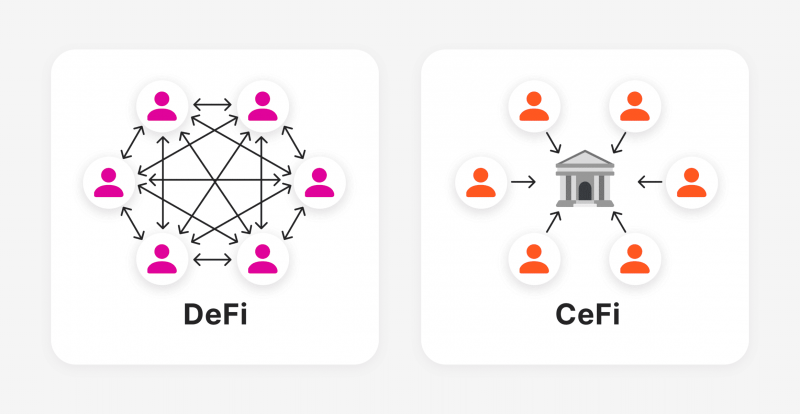
Thus, decentralised exchanges take an easy win in this aspect, creating a completely anonymous field for users to enjoy the core principle of blockchain. However, this significant advantage comes with considerable drawbacks in multiple areas.
Liquidity, Or Lack Thereof
Liquidity provision is one of the crucial factors in the crypto field. Aside from Bitcoin, Ethereum, and (mostly) USDT, even major altcoins suffer from frequent liquidity issues. The fundamental problem is that most altcoins don’t have inherently strong value or commodities to back their price stability. Thus, their prices and volumes tend to swing almost exclusively according to the demand of the trading customer base.
Thus, various liquidity providers are essential in the crypto landscape, as they supply the market with enough funds to keep the trading markets active and allow investors to find matching orders conveniently. Centralised exchanges find it much easier to integrate liquidity options into their systems and apply the liquidity pools to correct points in the currency pairing landscape. On the other hand, decentralised exchanges struggle with the same concept, as they utilise automated market makers (AMMs) to achieve the same result.
AMMs are designed to fill up liquidity pools within the exchange automatically. Regarding DEX platforms, liquidity pools are mostly filled up by individual users who stake their crypto funds for passive income opportunities. There are two significant problems: AMM liquidity pools are considerably less substantial than their centralised counterparts. They are also ineffective in many cases, as AMM algorithms struggle to juggle the complex liquidity process masterfully. Thus, DEX platforms frequently experience liquidity shortages or breakdowns, resulting in dire consequences for their customer base.

User Accessibility
Arguably, the most significant advantage of centralised exchanges is their ability to provide seamless customer service, smooth user interface and highly high-quality services in general. The third-party supervision capabilities allow centralised platforms to resemble conventional fiat exchange platforms closely. Thus, users can trade with crypto assets in a familiar and optimised environment that removes unnecessary complexities.
Each trading option, feature, analytics tool and modification opportunity is presented concisely and explained with numerous tips and guidelines. However, the biggest attraction here is that each trading mechanism can be executed with a swift click of a button. Users don’t have to do any of the technical work to finalise their currency exchanges or any other trading operations.
Unlike centralised exchanges, DEX platforms are pretty complex, requiring users to have extensive knowledge regarding gas fees, transaction processing, order matching, and various other crypto-specific concepts. While the entire process is far from rocket science, it requires much effort on the side of newcomer crypto owners. The sheer complexity of DEX platforms has caused many average users to switch off. As of 2023, the problem persists as DEX developers struggle to optimise their platforms to suit the needs of average consumers.
Regulatory Compliance
Last but not least, regulations are a crucial variable in crypto. The recent collapse of FTX and the corresponding crypto winter of 2022 has motivated regulatory bodies to tighten their approach to crypto-related laws. More regulation means heightened security and protection for regular platform users. However, more regulation could also imply limited freedom to conduct transactions freely and without arbitrary restrictions.
While DEX platforms are largely unregulated, they can provide the freedom above at the cost of significant risks. Lack of regulations means heightened counterparty risk, market risk and a variety of other elevated threats. On the other hand, centralised exchanges are enforced to keep their customers safe from various digital risks, which limits their ability to provide unconditional freedom of choice. There are no clear winners or losers in this aspect, as different investors could value freedom over security or vice versa.
However, the recent FTX collapse has severely impacted the crypto consumer base, motivating them to be more risk-averse in the short term. So, for the time being, centralised exchanges are also winning in this aspect.
The Best Centralised Crypto Exchange in 2023
Currently, Binance is the best and most popular centralised crypto exchange by a pretty wide margin. Boasting state-of-the-art trading tools and analytics, accessible UI and tight spread margins, Binance is simply the premier exchange platform the crypto world offers. Moreover, Binance’s extensive fund pool and large-scale outreach enable the platform to present favourable transaction fees.
Binance features over 150 currency pairings and provides free trading opportunities for Bitcoin. The remaining altcoins can also be purchased at highly affordable prices. One major downside of Binance is the uncertain regulatory environment. In 2023, the SEC filed several charges against Binance, requiring the exchange juggernaut to provide more transparency in their disclosures. It is unclear if Binance will walk away unscathed from this massive trial.
However, everything points to the fact that Binance will fully recover and continue its dominance as the most reliable, accessible and seamless centralised exchange on the market.
The Best Decentralised Crypto Exchange in 2023
Uniswap currently occupies the title of the best decentralised crypto exchange. Created in 2018, uniswap is by far the most successful implementation of the DEX platform, offering full decentralisation, complete self-custody and transparency.
Moreover, Uniswap has made tremendous strides in polishing its user interface and offering a decentralised, convenient environment for average crypto owners. Liquidity is often another pressing concern for DEX platforms, and Uniswap has presented more effective liquidity management options. While still largely automated, Uniswap’s liquidity pools are not much more efficient in distributing the pool funds and maintaining prices by market averages.
Slowly but surely, Uniswap is on the pace to solve some of the most fundamental issues faced by DEX platforms. While it is still nowhere as accessible, fast and cheap as Binance or other popular CEX options, Uniswap is on the right track to combine the best of both worlds. It will be fascinating to see if Uniswap jumps over accessibility and liquidity roadblocks to become a go-to decentralised cryptocurrency exchange.
Final Takeaways
Both centralised and decentralised variations of exchange platforms serve essential purposes in the crypto market. The former ensures that crypto owners can trade in a familiar and smooth environment, while the latter tries to fulfil the initial promise of blockchain technology with varying results. While the end goal should be to create a perfect hybrid between these variants, the crypto landscape must sacrifice convenience or decentralisation benefits.
However, with recent efforts to prioritise the core pillars of crypto technology once again, the crypto market could receive a platform that merges all the above-discussed benefits. Until then, weigh your options carefully and select a crypto exchange platform that prioritises your distinct needs.
FAQ
Is Binance centralised or decentralised?
Binance is very much centralised in its current version since centralised technology enables it to provide the most accessible, optimised, affordable and varied trading options on the market.
What is the biggest decentralised crypto exchange?
Uniswap is the biggest DEX platform, offering the most advanced automated market maker (AMM) algorithm and relatively convenient trading options. It is still far from achieving the accessibility levels of Binance or other CEX platforms.
Which is best – centralised or decentralised exchange?
It all depends on your specific needs and preferences. Decentralised exchanges are great for individuals who prefer complete anonymity and minimal third-party intervention. Conversely, users who prioritise convenience, accessibility and overall simplicity will do best to go with CEX platforms.
